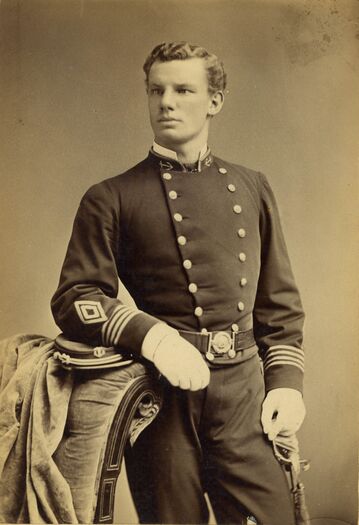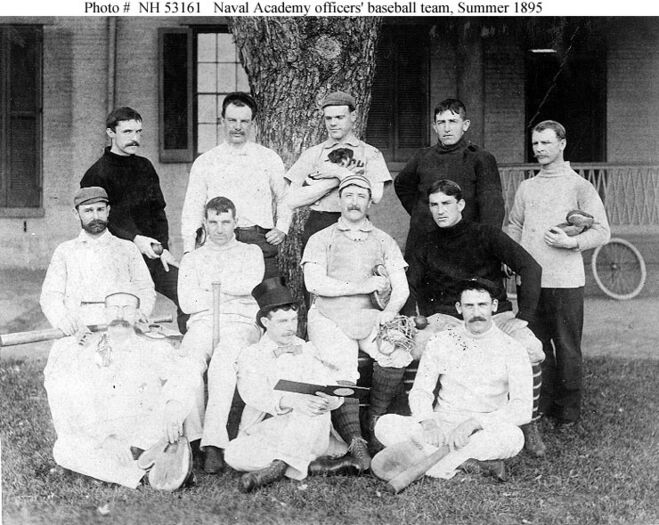FRANCIS J. HAESELER, LT, USN
Francis is currently listed with his classmates in Memorial Hall. However, we have recommended to the Memorial Oversight Committee at the US Naval Academy that he be removed for the reason listed at the bottom of this page; his loss was not due to hostile action or the result of his military duties.
His entry remains below so we do not lose his memory or the knowledge of his life and service.
Francis Haeseler '80
Francis Joy Haeseler was admitted to the Naval Academy from Pennsylvania on September 12, 1876 at age 16 years 5 months.
Photographs
"Officers' baseball team, Summer 1895. Those present are, seated in front, left to right: Assistant Engineer Herman O. Stickney; Ensign Samuel R. Hurlburt; and Ensign Ashley H. Robertson. Seated in middle row, left to right: Ensign Edward W. Eberle; Ensign William H.G. Bullard; Ensign John F. Hubbard (Catcher); and Professor Paul J. Dashiell. Standing in back, left to right: Ensign George R. Marvell; Lieutenant Francis J. Haeseler; Assistant Engineer Horace W. Jones (holding puppy); Second Lieutenant Charles F. Macklin, USMC; and Passed Assistant Surgeon Stephen S. White."
Loss
Francis died of typhoid fever at the New York Naval Hospital on November 20, 1900.
Other Information
From researcher Kathy Franz:
Francis’ father was Charles Herman, a homeopathic doctor, who came to the United States from Germany when he was three. His mother was Anna, his brother was Herman, and his sister was Louisa. His grandfather Charles was also a doctor who was the founder of homeopathy in the Pottsville area of Pennsylvania where they lived. Francis’ father served during the Civil War and wrote an article on the battle of Gaines’ Mill in June 1862.
Francis served well in the Navy earning excellent marks at the Naval Academy. He served several years later as an instructor at the Academy (1885-89 and 1892-95.) An accomplished electrician, he was also expert in the application of compressed air in mechanics. He invented several improvements in gun mechanics, and at his death, several of his “current clever and simple breechlocks” were being tested at Indian Head.
He served two years on the battleship Texas in the Spanish War under Admiral John W. Philip and was recommended several times for meritorious services. The Texas was the “hoodoo” of the Navy and was considered unmanageable. Francis was asked to give his plans for handling her, and Vice President-elect Teddy Roosevelt thought well of Francis and his plans. Francis improved the method of loading the big 12-inch guns making them rapid firers as the charge could be carried to the gun in any position. He made it safer to handle the big guns by altering the electric firing system so that a gun could not be discharged until the breechlock was completely closed. In the battle off Santiago on July 3, 1898, he was in charge of the starboard turret and aided greatly in the destruction of Cervera’s fleet. Morris Brown (Class of 1898) and William K. Gise (Class of 1893) were also on board the Texas.
Francis attended his father’s 70th birthday party in Pottsville on March 30, 1900. He became ill in November, and his doctors treated him for malaria. His friends felt that his life could have been saved if the doctors realized he had typhoid fever rather than malaria. Francis’ wife Alice P. (Smith) received a pension from the Veteran’s Administration. They were married in 1886, and their daughter Louise was stillborn on November 16, 1897.
Francis's brother Charles Herman named his son Francis Joy Haeseler, born December 10, 1896 in Pennsylvania. The younger Francis later served in WWI.
He is buried in the Naval Academy Cemetery.
Other
Francis wrote a chapter in the book "The life and adventures of "Jack" Philip, rear admiral, U. S. N.", in which he describes the battleship Texas's preparations for war, and then her action in the Spanish-American War at the Battle of Santiago de Cuba.
Jack Philip, Francis' commanding officer, forwarded the memo below to the Commander-in-Chief, North Atlantic Station (Admiral Sampson). From Naval History and Heritage Command:
Lieutenant Francis J. Haeseler To Captain John W. Philip
U. S. S. TEXAS,
Santiago de Cuba,
July 2nd., 1898Sir,
I beg to call your attention to the following plan for attempting to dismount the guns of the Western Battery by gun fire. [The western battery of Morro Castle (El Morro) at the entrance to Santiago de Cuba harbor.]
The angles of fall for the different calibres of great guns of this ship average, at 1600 yards, about 1" 50', which is also the angle of sight for this battery at that range; therefore, at this point in the trajectory the projectile is traveling in a horizontal line which will reduce to a minimum the error due to an error in estimating the range.
I beg to suggest that if the ship engages this fort at from 3000 to 2500 yards, or less, until it is silenced, and then closes to fifteen hundred yards, she will be able to use the secondary battery with great effect, keeping the guns of the forts silenced while an attempt is made to dismount them with the main battery. One ship alone will make the firing to be much more accurate and it is believed that these guns could be dismounted in this manner with a less expenditure of ammunition and with less danger to the crew than by general firing at longer ranges. If necessary, ships could relieve each other at the firing point, which could be indicated by anchoring a box or other object which would not look like a buoy, with a piece of cod line and a small anchor, thus enabling an accurate range to be used when once determined.
The best light for firing at this fort is during the afternoon.
Very respectfully.
F. J. Haeseler
Lieut. U.S.Navy
Career
From Naval History and Heritage Command:
Cadet Midshipman, 22 September, 1876. Graduated 22 June, 1882. Ensign, Junior Grade, 3 March, 1883. Ensign, 26 June, 1884. Lieutenant, Junior Grade, 9 January, 1893. Lieutenant, 11 October, 1896. Died 20 October, 1900.
Memorial Hall Error
Illness is not a criteria for inclusion in Memorial Hall.

